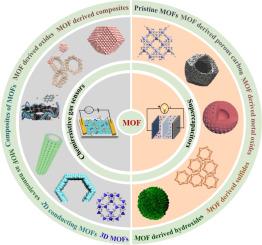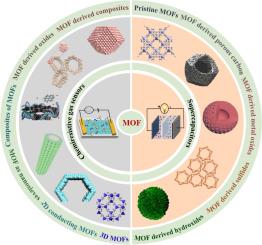用于超级电容器和气体传感器的基于mof的混合材料的变革进展:可持续技术的多功能平台
IF 23.5
1区 化学
Q1 CHEMISTRY, INORGANIC & NUCLEAR
引用次数: 0
摘要
向清洁和可持续能源系统过渡对于应对包括温室气体排放、污染和气候变化在内的全球环境挑战至关重要。在此背景下,用于储能的超级电容器和用于环境监测的气体传感器已成为促进能源和生态可持续性的关键技术。材料科学的进步促进了多功能平台的发展,金属有机框架(mof)因其高表面积、可调孔隙度、明确的结构和丰富的活性位点而脱颖而出。这些特性使得mof非常适合超级电容器和气敏应用。最近的进展包括开发原始mof基材料及其与导电聚合物、碳质材料和金属氧化物的复合材料,旨在提高导电性、稳定性和灵敏度。这些混合系统显著提高了电容性能和气敏选择性。尽管取得了这些进展,但关于mof及其复合材料在化学气体传感器和超级电容器中的双重应用的全面综述仍然有限。本文通过对近期进展的统一概述和研究材料结构如何影响设备功能来弥合这一差距。它还概述了在符合全球发展目标的可持续技术中实施基于mof的智能材料的当前挑战和未来机遇。本文章由计算机程序翻译,如有差异,请以英文原文为准。


Transformative progress in MOF-based hybrid materials for supercapacitors and gas sensors: multifunctional platforms for sustainable technologies
The transition to clean and sustainable energy systems is critical for addressing global environmental challenges, including greenhouse gas emissions, pollution, and climate change. In this context, supercapacitors for energy storage and gas sensors for environmental monitoring have emerged as key technologies for promoting energy and ecological sustainability. Advancements in materials science have enabled the development of multifunctional platforms, with metal-organic frameworks (MOFs) standing out due to their high surface area, tunable porosity, well-defined structures and abundant active sites. These properties make MOFs highly suitable for both supercapacitor and gas sensing applications. Recent advances include the development of both pristine MOF-based materials and their composites with conductive polymers, carbonaceous materials, and metal oxides, aimed at enhancing electrical conductivity, stability and sensitivity. These hybrid systems have led to significant improvements in capacitive performance and gas-sensing selectivity. Despite these advancements, a comprehensive review that addresses the dual application of MOFs and their composites in chemiresistive gas sensors and supercapacitors remains limited. This article bridges that gap by presenting a unified overview of recent progress and examining how material structure influences device functionality. It also outlines current challenges and future opportunities for implementing MOF-based smart materials in sustainable technologies aligned with global development goals.
求助全文
通过发布文献求助,成功后即可免费获取论文全文。
去求助
来源期刊

Coordination Chemistry Reviews
化学-无机化学与核化学
CiteScore
34.30
自引率
5.30%
发文量
457
审稿时长
54 days
期刊介绍:
Coordination Chemistry Reviews offers rapid publication of review articles on current and significant topics in coordination chemistry, encompassing organometallic, supramolecular, theoretical, and bioinorganic chemistry. It also covers catalysis, materials chemistry, and metal-organic frameworks from a coordination chemistry perspective. Reviews summarize recent developments or discuss specific techniques, welcoming contributions from both established and emerging researchers.
The journal releases special issues on timely subjects, including those featuring contributions from specific regions or conferences. Occasional full-length book articles are also featured. Additionally, special volumes cover annual reviews of main group chemistry, transition metal group chemistry, and organometallic chemistry. These comprehensive reviews are vital resources for those engaged in coordination chemistry, further establishing Coordination Chemistry Reviews as a hub for insightful surveys in inorganic and physical inorganic chemistry.
 求助内容:
求助内容: 应助结果提醒方式:
应助结果提醒方式:


